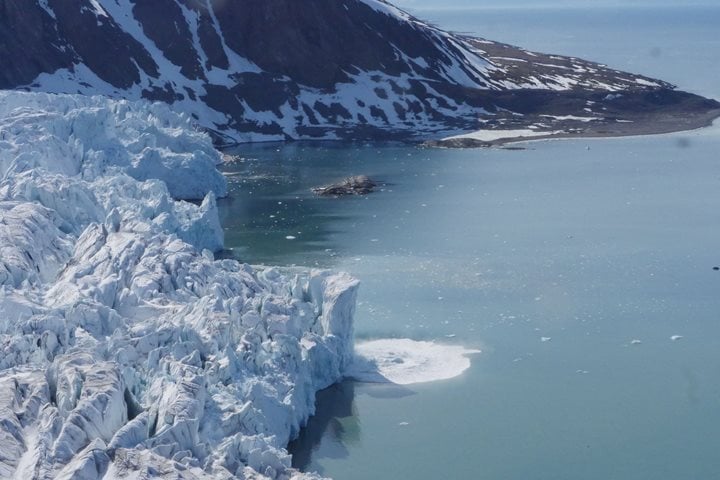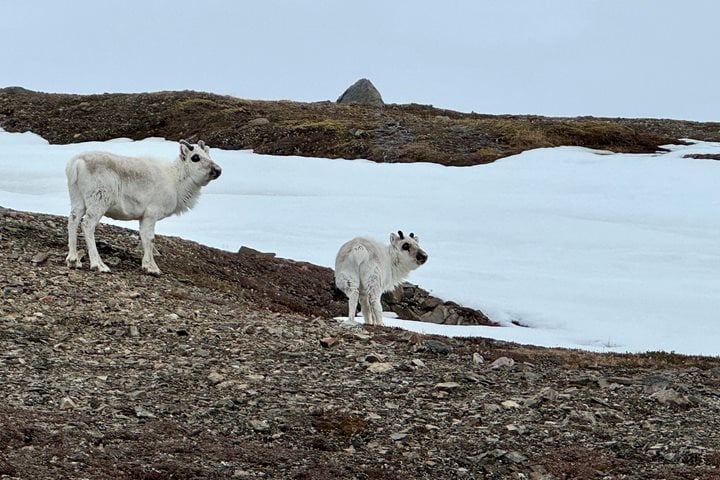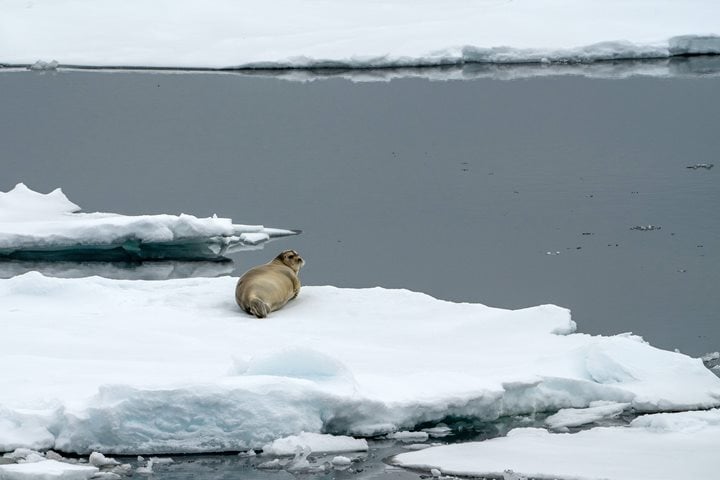In stark contrast to yesterday’s outing on the seemingly barren landscape at Gåshamna, a more recently glaciated valley, the lush carpet of High Arctic tundra we experienced this morning at Russebukta made for a good reminder of just how diverse and beautiful the High Arctic can be. This low and gently rolling plain with scattered rocky outcroppings and tundra ponds is a perfect place to explore the many facets of life here.
We set out in many directions from the landing to stroll across the tundra, kneel down and gaze at the macro-explosions of wildflowers, observe tundra nesting birds and even have a close look at Svalbard reindeer (rangifer tarandus platyrhynchus). The many tundra ponds here make for excellent habitat for the birds that migrate to Svalbard to take advantage of the midnight sun and abundant resources found here. Among them are the further-north breeding song bird, the snow bunting (plectrophenax nivalis), king and common eider (somateria spectabilis & mollisima) the purple sandpiper (calidris maritima), and the red (grey) phalarope (phalaropes fulicarius). This charasimatic and distinct-looking member of the wading birds exhibits an unusual trait in that the females of this species have more brightly colored and distinctive plumage than that of the males. Likely because it’s the males that take care of the nesting, incubating and raising of the chicks until they fledge, leaving the females to breed with more than one mate in this polyandrous breeding system.
The remainder of the day would be set aside for exploring the various bays and fjords (that still have the winter’s fast ice clinging to them) in hopes of spotting marine mammals utilizing this critical habitat. During the afternoon we heard a lecture from our Global Perspective Guest Speaker, Dr. Jared Diamond, on Norwegian history.
Mid-afternoon, while cruising the margin of a stretch of fast ice of the coast of Barentsøya, a cream-colored object was spotted from the bridge among the near-solid fast ice – a polar bear (ursus maritimus) lying down at rest or perhaps waiting silently for a seal to emerge from the ice. We had to approach the bear as carefully as we could in order to not disturb either it or the icy habitat it relies on. There are few sights in the natural world more exciting and fulfilling that watching such a magnificent and specialized animal as a polar bear in its natural habitat.
As the day turned into evening – only noticeable on the clock or one’s wrist, as the sun still hung high in the sky – we set a course for another potential locale that likely had good fast ice and thus habitat for marine mammals. Dinner had nearly ended when one of our watchmen and reliable spotters, Morel, saw the first of what would turn out to be three polar bears in an expansive area of ice near the northeastern coast of Spitsbergen Island at the base of Negribreen Glacier. The lone bear turned into two bears upon closer inspection. This sow bear and her two-year-old cub were both at rest or again “still hunting” seals about 200m apart from one another. Soon the cub and mother arose and reunited, strolling together for a time until coming to rest again on the ice, waiting for their next meal.
After having left mom and her cub to rest, we set out again along the margin of ice and after only a short distance another bear was spotted, having just moments earlier made a fresh kill of a young bearded seal (erignathus barbatus). We had observed it hauling the few-hundred pounds of seal out onto the pack ice to feed. It all had come together for us and the bear out here on the ice. All over the fast ice small dark sausage-like shapes can be seen scattered about. These are seals hauled out to rest and molt their fur in the still, warm, sunny conditions. Bears come here to take advantage of the concentration of available food. But good hunting techniques and patience for both bears and observers like us is paramount. This now-feasting bear was adorned with a radio telemetry collar used by the Norwegian Polar Institute to study and track the Svalbard population. Only females are collared and so we can infer that this bear was a female without any cubs out on her own making a living on the ice.
It wasn’t until 11 p.m. that we pulled away from our content bear and left her and the seals to their own. Quite a day and evening in the Midnight Sun.








